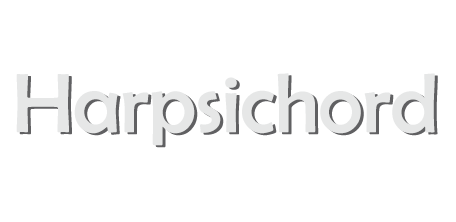
The Baroque period around the 16th century is considered to be an era when art was enhanced in a sophisticated form and style was used to define music in an exaggerated motion. Grandeur and exuberance accompanied the dance, theatre and music and the Harpsichord occupied a place of prominence due to its sheer ability to sound clear, brittle and formal. Distinguished by its large wing shape, the Harpsichord was an essential element of the ensemble of instrumental music played in the earlier centuries. The Harpsichord has its strings plucked rather than struck. But unable to change its dynamics, the Harpsichord was sidelined by the newly discovered and flexible piano. The modern music scene did not include it in the ensemble but of late it has witnessed a revival. It is a part of the keyboard family of musical instruments and is played by a Harpsichordist.
Invented in the Middle ages, the Harpsichord was first mentioned in the year 1514 in Italy. Venice (Italy) and Antwerp (Belgium) were the two centres of Europe where the manufacturing of Harpsichord took place in the 16th and 17th centuries. However, it had seen many variations in its construction. Italy and Netherlands introduced changes in its weight, decorations and tuning. Instrument makers from Germany, England, France and Italy added new dimensions to its construction. The Harpsichord became an important part of music in Europe around the period between 16th to 18th centuries. The Rucker’s family–built Harpsichords were highly valued. The French Blanchet family also built Harpsichords around 1750. The Harpsichord was prominent during the renaissance period but however, faded in the early 18th century. Recently, it is being revived in its historical form.

As with all the keyboard instruments, the Harpsichord also produces sound when it is struck or rather plucked. Sound of the metal strings is produced when it is plucked by the plectrum. The plectrum is a small piece of any material. A plectrum is attached to a narrow slip of wood called jack. This jack is attached to the working of the keys. A downward stroke on the key raises the plectrum. The raised plectrum plucks the string and then pivots without touching the string again on its way down. The tone of the Harpsichord is produced by a single pluck with no added variations. Variations such as a double key board and different set of strings were introduced to produce a better sound quality.

A distinguished, classical ancestor of the piano, a Harpsichord appears as a large–winged shaped instrument with stretched strings. Important components of Harpsichord include keyboard, casing, music desk, lid stick and the lid.

Wood type such as pine, poplar, maple, walnut and beech is used in the manufacturing of the Harpsichord and its components. Its keys are made from ebony or ivory. The various parts of the Harpsichord are cut, flattened and fitted together by hand. The soundboard is made from thin wood. The making of a soundboard is an elaborate process. It is made up of a number of slats. A column of ribs support the soundboard and its curvature. A large rib called the cut–off bar stiffens the soundboard and also adjusts the acoustics of the high and low sounds. The bridges are also glued to the soundboard. A detailed pattern of keyboard is marked on a single piece of wood. The bottom of the instrument is held by screws and glue and is made from two pieces of wood. The lid is made from a single piece. The Harpsichord is strung and jacks that pluck the strings are installed before the mounting of the keys, which are then attached to the jacks to finish the sound action. The instrument is then tuned and decorated and is ready to be played.

Due to its inability to change the dynamics, the Harpsichord was mostly considered as a continuo instrument and is played solo as per the player’s will. The Harpsichord was also played in concerts, chamber music and popular music. The 20th century revival of the instrument saw the Harpsichord being played in popular music, films and computer games.

Types of Harpsichord include:
- Spinet Virginals: The keyboard is placed to the left side.
- Muselar Virginals: The keyboard is placed in the right or the centre.
- Spinet: The strings are placed at an angle of about 30° to the keyboard.
- Clavicytherium: It is a Harpsichord that is vertically–stringed.
- Ottavino: This Harpsichord is with a four feet pitch.

Amongst the most notable composers of the Harpsichord were J.S Bach, Joseph Haydn and Wolfgang Amadeus Mozart during the 16th and the 17th centuries. The Harpsichord saw its revival through the works of Harpsichordist Violet Gordon–Woodhouse and Wanda Landowska. John Cage and Lejaran Hiller played the Harpsichord in the modern 20th century compositions.
Harpsichord is a member of the keyboard family of musical instruments. It is played by a Harpsichordist. For beginners, it may take some weeks, a few months or a year or more to learn to play the Harpsichord. The Royal College of Music London and College of Music at University of Colorado Boulder, US, teach the Harpsichord. Some of the steps involved in learning a Harpsichord include:
- While learning to play the Harpsichord, adopting the correct posture is necessary. One should sit in the centre of the keyboard. Relaxed and natural position with the elbows and wrists in a straight line is a must.
- The elbows and the wrist should be in line with the level of the keyboard.
- The five fingers of each hand should cover three of the harpsichord keys. Each hand should be used separately.
- One finger should cover one key. This is the ideal five finger position. The low sounds are played with the left hand whereas high notes with the right.
- Start playing to a rhythm.
G Kowledge of | 0 Comments >>
0 Comments
Leave Comment
Your email address will not be published. Required fields are marked.